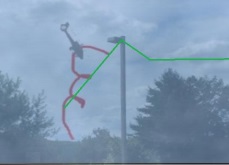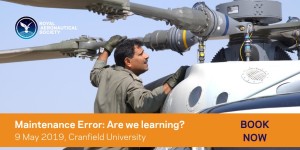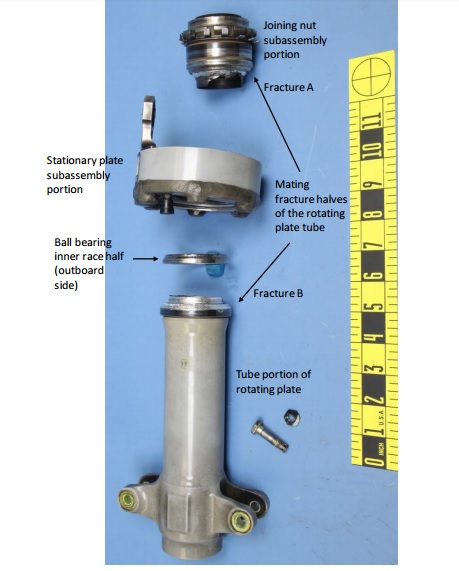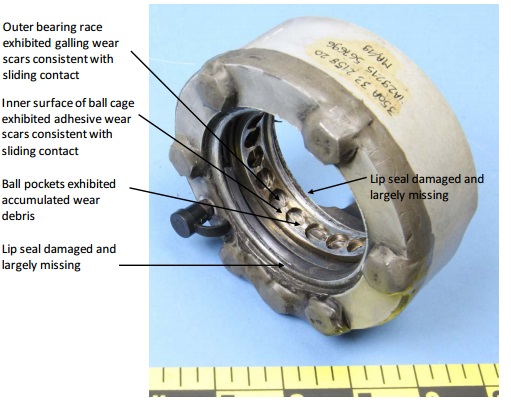For Rotors Grease is the Word
We look at two helicopter accidents (one fatal) where grease, and in particular the absence of grease, were critical factors.
Case 1: AS355F1 N58020 15 September 2012, New Jersey (One Fatality)
The National Transportation Safety Board (NTSB) report that, Airbus Helicopters AS355F1, N58020 operated by charter operator Analar Corporation was making a positioning flight to Atlantic City, NJ:
During cruise flight, witnesses on the ground reported hearing a grinding or popping noise, which was followed by the separation of the yellow main rotor blade.
In the NTSB Public Docket there is an eyewitness interview based report compiled using the innovative Immersive Witness Interview application from IWI.

Reconstruction of Witness #1 Viewpoint – As Described in Red with Radar Data in Green for AS355F1 N58020 (Credit: IWI via NTSB).
The pilot, the sole person on board, was killed.
The NTSB go on:
Examination of the fore/aft servo revealed that the internal threads of the upper rod end fitting on the servo were severely worn. The lower threaded portion of the upper rod end was not found secured into the servo’s upper end fitting and was not recovered. Additionally, the upper end fitting was packed with soil as the lower threaded portion of the upper rod end had separated from it prior to ground impact.
A 100-hour maintenance inspection of the accident helicopter had been completed on the morning of the accident and a 600-hour inspection of the accident helicopter was completed about 3 months prior to the accident. Neither inspection detected the worn threads on the fore/aft servo upper end fitting.
The operator used Mastinox, a corrosion inhibiting compound, during installation of the upper rod ends to the right-roll, left-roll, and fore/aft servos.
The helicopter manufacturer’s maintenance manual listed only G.355 grease and did not prescribe for the use of Mastinox.
However, the standard practices manual stated that a torque correction factor of 0.4 is used for G.355 grease, but not for Mastinox, since the latter is not a lubricant. The torque value listed in the manual for the rod ends already took a torque correction factor into account. A higher torque value would theoretically have been necessary when Mastinox was used in place of G.355 grease. The operator stated an adjusted torque value was not used during installation of the upper rod ends using Mastinox.
Evidence of sealant at the junction of the upper rod end and nut, which was required to be applied during servo installation per the maintenance procedures, was not found on either the right-roll or left-roll servos. While the lack of sealant may not result in a catastrophic event, its breakage or absence (and/or radial play of a servo end bearing) noted during a maintenance inspection could be indicative of a loss of torque.
Review of the helicopter manufacturer’s checklists and maintenance manuals revealed some guidance for servo inspections. The daily operating check (after the last flight of the day) included an instruction to check the main rotor servos for security and absence of leaks. The 600-hour inspection called for checking the radial play of the end bearings; however, there were no instructions to specifically check the threads of the servo end fitting or the torque of the rod end nut.
The NTSB determined the probable cause to be:
Disconnection of the upper rod end from the fore/aft servo due to severely worn threads, which resulted in a loss of control and separation of a main rotor blade during cruise flight.
Contributing to the accident were incorrect maintenance procedures and inadequate maintenance inspections performed by the operator, and insufficient inspection criteria provided by the helicopter manufacturer.
Case 2: AS350B2 N814EH 13 March 2015, Alaska
In a more recent report the NTSB describe how an Airbus Helicopters AS350B2, N814EH, operated by Erickson Air-Crane, was making a passenger flight from Anchorage to Beluga, Alaska:
The pilot reported that, while the helicopter was in cruise flight, about 1,000 ft above ground level, he felt a “clunk” in the tail rotor control pedals. Immediately thereafter, the helicopter began to yaw left. The pilot attempted to counteract the yaw by pressing the right tail rotor control pedal up to its forward stop, but the helicopter did not respond. The pilot declared an in-flight emergency with air traffic control, returned to the departure airport, and executed an emergency run-on landing.
The three people on board were uninjured after the skilful landing.
An examination of the helicopter revealed that the tail rotor pitch change spider assembly had fractured into two pieces…
Further examination revealed that the spider assembly failure was consistent with bearing seizure.
No evidence of grease was found on the bearing surfaces or the bearing housing. A review of maintenance records revealed that, about 13 months before the accident, the pitch change spider assembly was overhauled by a certified repair station, during which the original ball bearing was replaced. According to the helicopter manufacturer’s spider assembly overhaul procedures, grease was to be applied during the installation of the new bearing.
The spider assembly was installed on the helicopter by the operator’s maintenance personnel about 1 month later, at which time a mechanic signed off completing the helicopter manufacturer’s 600-flight-hour/24-month inspection checklist, which included regreasing the bearing. The bearing failed about 10 months and 141 flight hours after the spider assembly was installed on the helicopter.
Given that no grease was found on the fractured components and that the signatures were consistent with thermal damage due to a bearing seizure, it is likely that the overhaul facility did not follow the helicopter manufacturer’s overhaul procedures and failed to apply grease to the bearing. During the subsequent installation of the overhauled spider assembly, it is likely that the mechanic presumed that the newly overhauled spider assembly bearing contained grease and, therefore, did not complete the bearing regreasing procedure in accordance with the inspection checklist, which led to the lack of grease in the bearing going undetected.
Full details of the lab examination can be found in the NTSB Public Docket.
The NTSB determined the probable cause to be:
The failure of the ball bearing within the pitch change spider assembly due to its operation with no grease within the bearing, which resulted in the subsequent fracture of the spider assembly and a loss of tail rotor control authority.
Also causal to the accident were the overhaul facility’s failure to follow the helicopter manufacturer’s spider assembly overhaul procedures, which resulted in the assembly leaving the facility with no grease in the bearing, and the mechanic’s failure to complete all of the tasks on the 600-flight-hour/24-month inspection checklist, which led to the lack of grease in the bearing going undetected.
Extra Resources
UPDATE 24 November 2019: IWI was also highly effective in aiding this investigation: Austrian Police EC135P2+ Impacted Glassy Lake
Aerossurance has also previously written these articles that should be of interest:
- Professor James Reason’s 12 Principles of Error Management
- How To Develop Your Organisation’s Safety Culture
- Maintenance Human Factors: The Next Generation
- Aircraft Maintenance: Going for Gold?
- Critical Maintenance Tasks: EASA Part-M & -145 Change
- Misassembled Anti-Torque Pedals Cause EC135 Accident
- EC130B4 Accident: Incorrect TRDS Bearing Installation
- Fatal $16 Million Maintenance Errors
- UPDATE 18 December 2016: Robinson R44 Power Loss: Excessive Lubricant
- UPDATE 28 January 2018: Wasp Stung By Lack of Lubrication An ex-military Wasp helicopter crashed out of control. The military Maintenance Schedule assumed 200FH pa and an MGB overhaul ever 600FH. This MGB was fitted for 429 hours over 20 years.
- UPDATE 23 February 2018: NTSB Reveal Lax Maintenance Standards in Honolulu Helicopter Accident The in-flight failure of the engine-to-transmission drive shaft of a Bell 206B3 due to omission of grease resulted in a fatal water impact, caught on video.
- UPDATE 8 September 2018: Torched Tennessee Tour Trip (B206L N16760) An ungreased fuel pump spline failed, the aircraft crashed and suffered a fatal post crash fire.
- UPDATE 9 May 2020: Ungreased Japanese AS332L Tail Rotor Fatally Failed
- UPDATE 5 September 2020: SAR AS365N3 Flying Control Disconnect: BFU Investigation
- UPDATE 9 July 2022: R44 Ditched After Loss of TGB & TR: Improper Maintenance
Maintenance Observation Programme (MOP)
Aerossurance worked with the Flight Safety Foundation (FSF) to create a Maintenance Observation Program (MOP) requirement for their contractible BARSOHO offshore helicopter Safety Performance Requirements to help learning about routine maintenance and then to initiate safety improvements:
Aerossurance can provide practice guidance and specialist support to successfully implement a MOP.
Aerossurance is pleased to be both sponsoring and presenting at a Royal Aeronautical Society (RAeS) Human Factors Group: Engineering seminar Maintenance Error: Are we learning? to be held on 9 May 2019 at Cranfield University.





Recent Comments